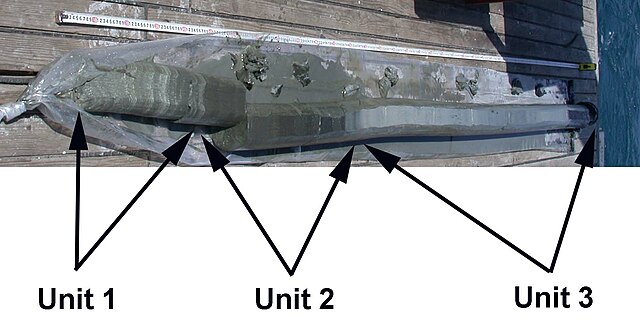Sapropel
Sapropel(a contraction of Ancient Greek wordssaprosandpelos,meaningputrefactionand mud (or clay), respectively) is a term used inmarine geologyto describe dark-colouredsedimentsthat are rich inorganic matter.Organiccarbonconcentrations in sapropels commonly exceed 2 wt.% in weight.
The term sapropel events may also refer to cyclic oceanicanoxic event(OAE), in particular those affecting theMediterranean Seawith a periodicity of about 21,000 years.
Formation
[edit]Sapropels have been recorded in the Mediterranean sediments since the closure of the EasternTethys Ocean13.5 million years ago. The formation of sapropel events in theMediterranean Seaoccurs approximately every 21,000 years and last between 3,000 and 5,000 years. The first identification of these events occurred in the mid-20th century. Since then, their formulative conditions of have been investigated.
The occurrence of sapropels has been related to the Earth's orbital parameters (Milankovitch cycles). Theprecessioncycles influence theAfrican monsoon,which influences theMediterranean circulationthrough increases in freshwater inputs.
Sapropels develop during episodes of reduced oxygen availability in bottom waters, such as an oceanicanoxic event(OAE). Most studies of formational mechanisms infer some degree of reduced deep-water circulation. Oxygen can only reach the deep sea by new deep-water formation and consequent "ventilation" of deep basins. There are two main causes of OAE: reduction in deep-water circulation or raised oxygen demand from upper level.
A reduction in deep-water circulation will eventually lead to a serious decrease in deep-water oxygen concentrations due tobiochemical oxygen demandassociated with the decay of organic matter. This sinks into the deep sea as a result ofexport productionfrom surface waters. Oxygen depletion in bottom waters then favors the enhanced preservation of theorganic matterduring burial by the sediments. Organic-rich sediments may also form in well-ventilated settings that have highly productive surface waters; here the high surface demand simply extracts the oxygen before it can enter the deep circulation current thus depriving the bottom waters of oxygen.
Significance
[edit]Sapropelic deposits from global ocean anoxic events form important oilsource rocks.Detailed process studies of sapropel formation have concentrated on the fairly recent eastern Mediterranean deposits,[1]the last of which occurred between 9.5 and 5.5 thousand years ago.
The Mediterranean sapropels of thePleistocenereflect increased density stratification in the isolated Mediterranean basin. They record a higher organic carbon concentration than non-sapropel times; an increase in the δ15N and corresponding decrease in δ13C tells of rising productivity as a result of nitrogen fixation.[2]This effect is more pronounced further east in the basin, suggesting that increased precipitation was most pronounced at that end of the sea.[2]
In the Black Sea
[edit]In theBlack Sea,sapropels are distributed at a depth of 500 to 2200 m, and in different morpholithological zones they have different thicknesses. Deep sea sediments are called the sediments formed outside the zone of influence of hydrogenic factors such as wind-driven waves and internal waves as well as of thetransgressiveandregressivecycles of the Black Sea basin. Here, under the conditions of relative stagnation, can be observed uninterrupted cross-sections because this area was under the sea level during the entire Pleistocene andHolocene.Deep sea organogenic mineral sediments (DSOMS) are those sediments that contain more than 3% organic carbon. The sapropels form a single horizon with constant thickness typical of the Black Sea basin. Analogues of the sapropels on thecontinental shelfand the upper part of thecontinental slopeare the greenaleurite-pelite,oozes with accumulation of plantdetritusand decomposed shells ofMytilus galloprovincialis.The transition from aleurite-pelitic oozes to sapropels is facial. The organic matter in the sapropels is of heterogeneous origin. They are composed primarily of planktogenic organisms (about 80%) and continental organic matter (20%). Theplanktonicorganisms are well preserved in most cases under the conditions of thehydrogen sulfidezone. The main components of the sapropels are thedinoflagellatecysts,diatomalgae,coccolithophorids,peridiniales.The mineral part of sapropel muds is represented by a poly-component mixture ofclay minerals.The mineralsilliteandmontmorillonitepredominate,chloriteandkaoliniteoccur in subordinate quantities. Individual grains ofquartz,feldspar,volcanic glassand others are rarely found among them.Carbonate mineralsare mainly represented bycalciteanddolomite.It is generally accepted that the main source of hydrogen sulfide in the Black Sea today are the processes of anaerobic decomposition of organic matter bysulfate-reducing bacteria(SRB). The organic substance that is fixed at the bottom of the basin in the form of organogenic-mineral sediments (sapropels) is a product of the mass extinction of the plankton biomass as a result of theBlack Sea flood.There is an excess of a huge amount of organic matter, which creates favorable conditions for the development of bacterial sulfate reduction. [3]

Non-conventional source of energy
[edit]Bulgarian ProfessorPetko Dimitrovis the creator of the idea for the application of sapropel sediments from the bottom of the Black Sea as a natural ecologicalfertilizerand biological products.[5][3]According to the Romanian tycoonDinu Patriciu,the sapropel sediments have the potential to be a source of non-conventional energy.[6]Patriciu has created a marine exploration project in the Black Sea which examines the sapropel sediments of that region. Sediment cores are collected and investigated by several universities and research institutes across the world.[6]
See also
[edit]- Pelite,mud rocks
References
[edit]- ^"Eelco J. Rohling, 2001,The Dark Secret of the Mediterranean,2001, School of Ocean and Earth Science, Southampton Oceanography Centre ".Archived fromthe originalon 2008-04-11.Retrieved2006-06-12.
- ^abPhilip A. Meyers and Michela Arnaboldia (2008). "Paleoceanographic implications of nitrogen and organic carbon isotopic excursions in mid-Pleistocene sapropels from the Tyrrhenian and Levantine Basins, Mediterranean Sea".Palaeogeography, Palaeoclimatology, Palaeoecology.266(1–2): 112–118.Bibcode:2008PPP...266..112M.doi:10.1016/j.palaeo.2008.03.018.
- ^abDimitrov D. (2010).Geology and Non-traditional resources of the Black Sea.LAP – Lambert Academic Publishing.ISBN978-3-8383-8639-3.244 p.Bibcode:2012QuInt.279R.119D,doi:10.1016/j.quaint.2012.07.527
- ^Peychev V., D. Dimitrov. 2012.Oceanology.Varna. Ongal.ISBN978-954-8279-82-6.476 p.
- ^Dimitrov P., et al. (2000).Amendment for soils and substrates,doi:10.13140/RG.2.2.28181.63205,Patent BG No. 63868, Register No. 104106.
- ^abPatriciu: Examination of sapropelic mud in Black Sea could last 2-3 years,19 June 2009, wall-street.ro, retrieved at 30 July 2010
